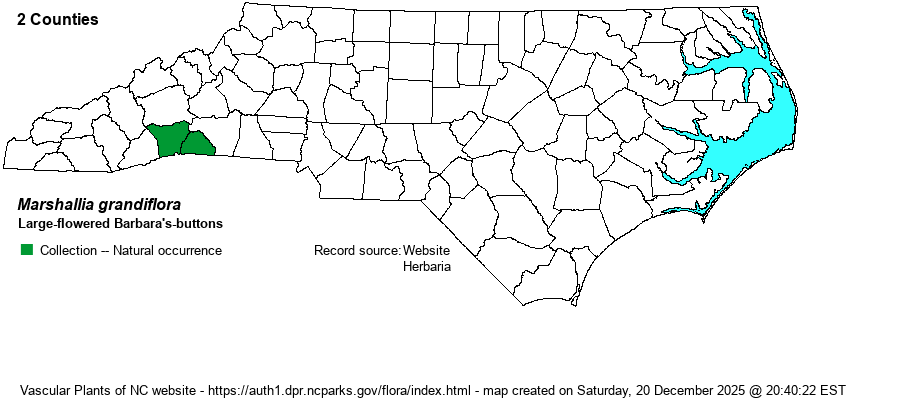| Author | Beadle & Boynton | |
| Distribution | Collected only from Henderson and Polk counties in the southern Mountains. Last seen in Henderson County in 1919 and in Polk County in 1898. Note that RAB (1968) listed a record for Granville County, in the northeastern Piedmont; that specimen was actually mis-allocated, and in reality it was an undescribed species (not known at the time), which is now the recently described M. legrandii.
Until a new paper by Knapp, Poindexter, and Weakley (2020, Phytotaxa, 447:1-15) was published, this species was known from southwestern PA to eastern KY, south to western NC and eastern TN. Now, this species, according to that publication, is/was limited only to NC -- a state endemic species. | |
| Abundance | Long historical (SH rank), but now (2023) considered as extirpated (SX) in the state and therefore extinct as a species (GX). In 2021, this species became State Special Concern - Historical. With the other portion of the species now re-named as M. pulchra, M. grandiflora is now considered presumed extinct. | |
| Habitat | Three specimens have habitat data as follows: "dry soil near Saluda, Polk Co."; "near Flat Rock, Henderson Co."; "swamps of Muddy Creek, Henderson Co.". FNA and Weakley (2018) say that it inhabits streambanks and cobble bars, especially with some scour action to keep woody competition retarded. The "Bogs" as listed in RAB (1968) is certainly not a correct habitat for this species in its range. |
| Phenology | Flowering and fruiting June-August. | |
| Identification | Marshallia grandiflora was very distinct, up to 2.5 feet tall and with broad, lance-shaped leaves, the lower ones on long stalks, the upper ones stalkless and shorter. Only 1-2 heads grew atop long stalks (one per stalk), the florets pink, the flower averaging about 1.5 inches across, larger than in other Marshallia species in the state. For separation from the new M. pulchra, see that 2020 paper. | |
| Taxonomic Comments | There was confusion when RAB (1968) was published about what actually constituted this species (see Distribution). Now, the former M. grandiflora has been split (in 2020) into two species, with the NC records retaining the name M. grandiflora, and the PA-WV-KY-TN populations being named as M. pulchra.
| |
| Other Common Name(s) | Appalachian Barbara's-buttons, Blue Ridge Barbara's-buttons, Giant Barbara's-buttons. The 2020 paper provides two common names: the first being Appalachian Barbara's-buttons and the second as Large-flowered Barbara's-buttons; one of the authors (Weakley) has also suggested Blue-ridge Barbara's-buttons. As M. trinervia occurs in the Appalachians also, and the Latin name grandiflora translates to "large flower", the website editors are selecting Large-flowered Barbara's-buttons as the preferred name. | |
| State Rank | SX | |
| Global Rank | GX | |
| State Status | SC-H | |
| US Status | | |
| USACE-agcp | | |
| USACE-emp | FAC link |

